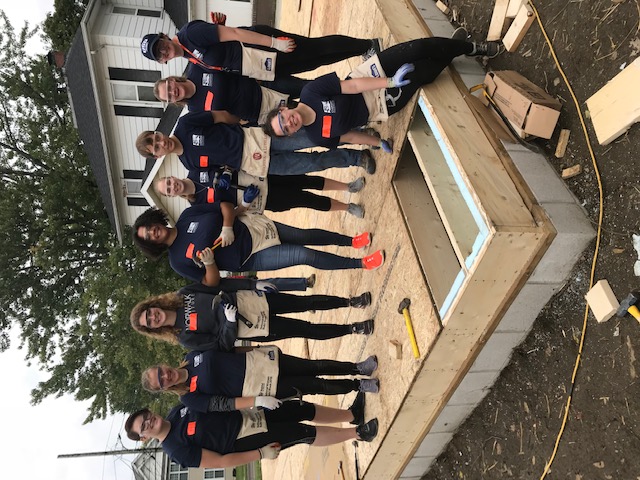Chapman Learning Community part of Habitat projects
From little libraries to family homes
 Chapman students at the Habitat for Humanity build site
Chapman students at the Habitat for Humanity build site
By Samantha Sharp
Bowling Green State University students have the chance to be involved in something bigger than themselves through high-impact learning experiences, which are enriched by an emphasis on social issues and community service. Recently, BGSU students played a constructive role in building a forever home for a local family.
Chapman Learning Community first began its relationship with Habitat for Humanity last spring with a substantial service-learning project that brought Little Free Libraries, a “take a book, return a book” exchange, to the Bowling Green community. The ultimate goal of the project was to promote education and literacy outside of the University. Using supplies purchased with a grant from Serve Ohio and the Bowling Green Rotary, student volunteers assembled 16 lending library boxes during the 2018 MLK Jr. Day of Service. With a future partnership between the University and Wood County’s Habit for Humanity chapter in mind, leadership from both organizations saw the little libraries as an opportunity to kick off a strong working relationship.
“Faculty, students and staff at the University have worked with Habitat for Humanity for years, and this was an opportunity to build on those relationships,” said Paul Valdez, associate director of the Center for Community and Civic Engagement.
The Little Libraries project demonstrated how different groups can come together to take on a social issue while making a positive impact in the community. Following the success of that project, Valdez and Dr. Brett Holden, academic affairs coordinator of BGSU learning communities and director of Chapman Learning Community, with a steering committee of faculty, staff and students, helped facilitate student participation on the construction portion of the first Habitat for Humanity house to be built in Bowling Green. The success of the first build was important for both parties because the University plans to contribute to two more builds for Habitat for Humanity’s “Build 3 in BG” plan.
Before the groundbreaking ceremony, the steering committee helped identify potential courses, student groups, faculty and staff to connect with the build in various ways. Those tasks included: house design ideas from an architecture and environmental design community-based learning course, construction materials lists and costs from the construction management department, fundraising and other written materials from students enrolled in a technical writing course, fundraising and community-outreach efforts from the Habitat for Humanity Campus Chapter, a “Name That Tune” fundraiser conducted by a tourism, leisure and event planning community-based learning course, Greek Week fundraising by fraternities and sororities, BGSU Athletics Community Spotlight nights featuring information on the build, and a social work program intern receiving fulfillment of the field placement requirement.
Volunteers who specifically worked on the actual building of the home in the fall semester were also recruited from Chapman, the Achievement in Math and Science Program, the Business District Learning Community and the ECCO Learning Community.
The Manville Avenue building site is a short walk from the southwest edge of campus, which was an incentive for students to participate. Because most students had never touched a power tool before stepping foot on the site, many were taught by skilled Habitat for Humanity supervisor volunteers how to operate tools and how to complete construction tasks without feeling any embarrassment about their lack of carpentry knowledge. While the professionals oversaw the work site and the more dangerous tasks, they also taught student volunteers valuable skills like working together and staying focused on the quality of their work.
“Some of the students had never driven a nail in their life, and this gave them the opportunity to learn real life skills that they might not have gotten the chance to experience,” Holden said.
Chapman Community member Erin Coran is one student who gained carpentry skills while working on the build. She first interacted with Habitat for Humanity through the Little Libraries project, where she learned more about their mission to serve families in the community. In addition to the community-based learning experience, Coran said that her participation in both projects gave her the opportunity to branch out from student activities and “learn more about the surrounding area of Bowling Green outside of campus life.”
“Although I do not know if I will utilize these skills again, I did gain confidence that will stay with me for years to come,” she said. “It was empowering, especially as a woman, to be able to engage in a carpentry project like this.”
For learning community students, service work does not come without critical thinking and analysis of the social change their activities create. Each time they complete a community-based learning project, they are expected to either write a reflection paper or take part in a debriefing that will help them connect and apply what they are learning to their academic and professional careers.
Holden stressed that community-based learning projects help students learn their role in the world, which helps them get through a productivity paralysis that can happen upon college graduation.
“I’ve never seen a generation of highly motivated students so invested in joining something bigger than themselves in my life,” Holden said. “Before Chapman, I used to have to pull teeth to get students enthusiastic and involved; now I’m pulling out my own hair trying to find more stuff for them to do.”
Updated: 08/08/2019 04:35PM
